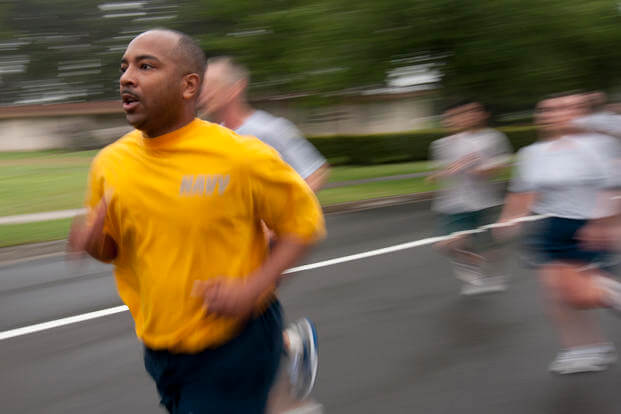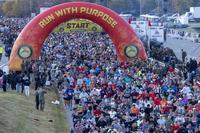This is an article recently written by a friend of mine, retired Royal Commando "Sol" Sollerer.
A number of people have approached me, saying they have reached a plateau in terms of how fast they can run five- and 10-kilometer races or even the military 1.5-mile physical fitness test (PFT). They want advice. Here it is.
In interval training sessions, you run for a set distance or for a set time -- 3-6 times, maybe more, during a run and generally full into the brackets of aerobic, cruise, sprint, negative splits or, for the highly conditioned athlete, Tabata intervals.
How interval pyramid tempo training works is like this, for example:
You presently are running a 9:20 mile-and-a-half (2,400 meters), and your goal is to run it in nine minutes.
You take the nine-minute goal and split that time down for the following distances:
|
2,400 meters = 9:00 goal |
(8:00 goal) |
(10:00 goal) |
|
1,200 meters = 4:30 |
(4:00) |
(5:00) |
|
800 meters = 3:00 |
(2:40) |
(3:20) |
|
600 meters = 2:15 |
(2:00) |
(2:30) |
|
400 meters = 1:30 |
(1:20) |
(1:40) |
|
200 meters = 0:45 |
(0:40) |
(0:50) |
You can see how easy the smaller distances are and how much harder the longer distances are going to be, according to your individual goal. Now you need a well-measured trail or preferably a running track.
After warming up, you are going to run each of the following distances at the target times set above, with a comfortable recovery pace in between for the distance stated:
2 x 200m with 200 meters slow recovery between each (remember 45 seconds. I bet you do the first 200 meters far too fast.)
1 x 400 meters with 200-meter slow recovery
1 x 400 meters with 400-meter slow recovery
1 x 600 meters with 400-meter slow recovery
1 x 800 meters with 400-meter slow recovery
1 x 600 meters with 400-meter slow recovery
1 x 400 meters with 200-meter slow recovery
1 x 200 meters with 200-meter slow recovery
Total distance run = 6,400 meters, with 3,800 meters run at the desired goal race pace and 2,600 run at recovery. You now can see how effective this sort of training is for 5K and 10K distances.
If you achieve all the times required in the example above, then you can take a 400-meter run out and put a 1,200-meter run at the top of the pyramid, or another 800 meters instead -- progressing the program until you achieve your goal. If you are not making the times required, you need to regress the distances rather than the time; keep the time the same -- as long as you are being realistic, only you know.
When you have progressed to having a 1,200-meter run at the top of your pyramid, with a couple of 800 meters, you are very likely to smash your goal time when it comes to race day. For a 5K goal, work toward putting a 2,400-meter run at the top of your pyramid.
This training approach has many advantages, such as, it does not tire the body like other training methods, so it is ideal for triathlon training or if you need to get more miles under your belt on other days. Also your body will adapt and get used to the pace you are setting, giving you a natural rhythm to run at that pace, as your anaerobic threshold rises. Additionally, as part of a training program, this method gives you a measurable mark of your fitness gains as you progress.
Some may say this is not a true interval, and that it is more Fartlek oriented. I say if it is Fartlek, then where is the random change of pace, or the hills and the different terrain? Whatever the training approach, it works.
Sol Sollerer joined the British Army at 18 and retired as a sergeant major after 22 years of service that included seeing active service in Northern Ireland, Bosnia, three tours in Iraq and a tour in Afghanistan. Sollerer was a military diver and commando, possibly two of the most physically and mentally demanding courses in the British Army.
Stew Smith is a former Navy SEAL and fitness author certified as a Strength and Conditioning Specialist (CSCS) with the National Strength and Conditioning Association. Visit his Fitness eBook store if you're looking to start a workout program to create a healthy lifestyle. Send your fitness questions to stew@stewsmith.com.
Want to Learn More About Military Life?
Whether you're thinking of joining the military, looking for fitness and basic training tips, or keeping up with military life and benefits, Military.com has you covered. Subscribe to Military.com to have military news, updates and resources delivered directly to your inbox.



















